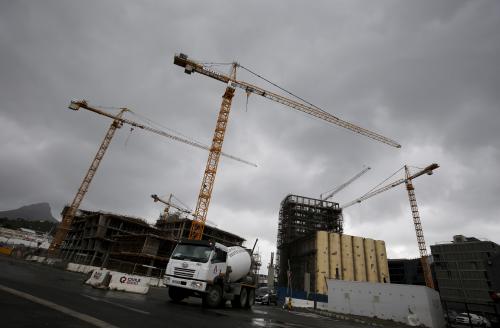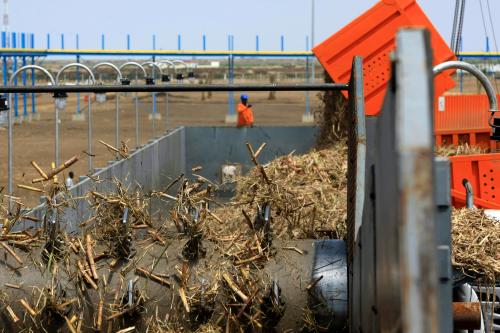Sunday, November 20, marked the United Nations’ “Africa Industrialization Day,” a day created to “mobilize the commitment of the international community to the industrialization of Africa.” This week, we take a look at the state of industrialization in sub-Saharan Africa, the lagged growth of the sector, the relative importance of industry for African development, and the solutions in place to develop the sector.
The average share of manufacturing in GDP, a standard measure of industrialization, has stagnated in sub-Saharan Africa at approximately 11 percent (Figure 1), the same level it has been at since the 1970s. Africa’s share of global manufacturing remains largely unchanged at just under 2 percent. Again, this figure is largely unchanged since the 1970s. Moreover, African countries are lagging behind their other developing nation counterparts: Manufacturing output per person remains at a third of the average for all developing countries. Many policymakers worry that Africa, because it is not industrializing quickly enough, will not be able to absorb the high number of quasi-skilled workers moving from rural areas to urban centers. Whereas output per person in the services sector is two times more productive than in the agriculture sector, output per person in the manufacturing sector is up to six times more productive than in agriculture, hence the importance for industrial development. In the five decades after World War II approximately half the catch-up by developing countries to advanced economy levels of output per worker was explained by rising productivity in industry in addition to large migration from rural to urban communities, as well as a shift of job opportunities from agriculture to manufacturing. Low levels of industrialization are a cause for concern among many policymakers.
Figure 1: Industry share of sub-Saharan Africa GDP
 Source: Brookings Foresight Africa 2016; The World Bank: Development Indicators: World Bank national accounts data, and OECD National Accounts data files
Source: Brookings Foresight Africa 2016; The World Bank: Development Indicators: World Bank national accounts data, and OECD National Accounts data files
Policymakers from around the world have taken notice of this trend. President of the African Development Bank Akinwunmi Adesina, highlighted his “Industrialize Africa” program as one of the top five priorities for the next decade. The United Nation’s Sustainable Development Goal 9 calls for the world to build resilient infrastructure, promote sustainable industrialization and foster innovation. The World Bank, African Union (AU), United Nations Industrial Development Organization (UNIDO), and the United Nations Economic Commission for Africa (UNECA) have all stressed the development of a robust manufacturing sector as key to Africa’s long term sustainable growth.
Africa has seen some success stories but these are generally limited. As UNIDO’s 2016 Industrial Development Report notes, while “export sophistication and product discovery,” intended to capture the extent of upgrading within global value chains, “are generally lower in Africa than in other developing regions […] Africa has made some progress in upgrading, and African countries have exported their products at higher prices while maintaining market shares. Such economic upgrading has observed across a broad range of sectors, particularly in electrical and machinery, transport, and other manufacturing industries.”
Figure 2: Upstream global value chain involvement, African countries, by sector 2010
 Source: UNIDO, 2015. Industrial Development Report 2016: The Role of Technology and Innovation in Inclusive and Sustainable Industrial Development.
Source: UNIDO, 2015. Industrial Development Report 2016: The Role of Technology and Innovation in Inclusive and Sustainable Industrial Development.
Figure 2, extracted from the above-mentioned UNIDO report, looks at the African countries’ involvement at different parts of the global value chain (GVC). We can observe that African countries are mainly involved in the provision of low-value-added primary production, i.e., the export of primary products, which makes up 25 percent of upstream GVC participation. The graph also shows the limited involvement of African countries in low and high tech manufacturing, which in aggregate make up 19.5 percent of upstream GVC participation. In addition to the provision of primary products, African countries are considerably involved in the provision of low and high tech services, which make up 55.5 percent of upstream GVC participation. The two figures in this post seem to indicate that Africa is leapfrogging past industrialization and into the service sector.
John Page, an Africa Growth Initiative senior fellow, has argued that bad policies are to blame for the lack of dynamism in Africa’s industrial sector. However, he also provides new policy direction in his book “Made in Africa: Learning to Compete in Industry.” In the book, he argues that exports, firm capabilities, and agglomeration have been responsible for driving firm-level productivity in East Asia; they are noticeably absent in Africa. Therefore, to industrialize, Africa needs not only policies to promote exports, develop industrial hubs and attract more FDI, but it also needs strong unwavering commitment from the leadership to ensure these reforms are pushed through. Strong high-level leadership, coupled with prudent policy, could spark the age of industrialized Africa.
Junaid Belo-Osagie contributed to this post.







Commentary
Figures of the week: Africa Industrialization Day
November 23, 2016